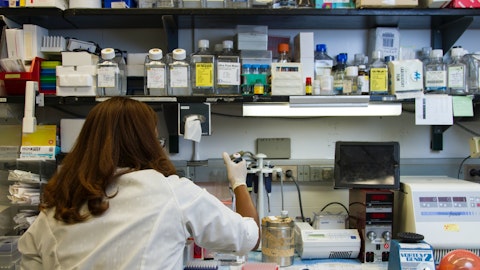AstraZeneca PLC (NASDAQ:AZN) Q4 2022 Earnings Call Transcript February 9, 2023
Operator: Good morning to those joining from the U.K. and the U.S. Good afternoon to those in Central Europe and good evening to those listening in Asia. Welcome, ladies and gentlemen, to AstraZeneca’s Full Year and Q4 2022 Results Conference Call for investors and analysts. Before I hand the call over to AstraZeneca, I’d like to read the safe harbor statement. The company intends to utilize the safe harbor provisions of the United States Private Securities Litigation Reform Act of 1995. Participants on this call may make forward-looking statements with respect to the operations and financial performance of AstraZeneca. Although we believe our expectations are based on reasonable assumptions, by their very nature, forward-looking statements involve risks and uncertainties and may be influenced by factors that could cause actual results to differ materially from those expressed or implied by these forward-looking statements.
Any forward-looking statements made on the call reflect the knowledge and information available at the time of this call. The company undertakes no obligation to update forward-looking statements. Please also carefully review the forward-looking statements disclaimer in the slide deck that accompanies this call. There will be an opportunity to ask questions after today’s presentations. I must advise that this conference is being recorded today. And with that, I will now hand you over to the company.
Andy Barnett: Thank you, operator and good afternoon, everyone. I’m Andy Barnett, Head of Investor Relations at AstraZeneca and I’m pleased to welcome you to AstraZeneca’s fourth quarter and full year conference call for 2022. We will also present our guidance for 2023 on today’s call. As usual, all materials presented are available on our website. Please advance to Slide 2. This slide contains our usual — this slide contains the — our usual safe harbor statement, where we’ll be making comments on our performance using constant exchange rates, or CER, core financial numbers and other non-GAAP measures. A non-GAAP to GAAP reconciliation is contained within our results announcement, numbers are a million dollars unless otherwise stated.
Please advance to the next slide. This slide shows the agenda for today’s call. Following our prepared remarks, we will open the slide for questions. We will try to address as many questions as we can during the allotted time. Please advance to the next slide. And with that, Pascal, I’ll hand over to you.
Pascal Soriot: Thanks, Andy, and hello, everyone. Welcome to today’s call. We can move to Slide 5. We delivered a strong 2022 performance, finishing the year with total revenue and EPS at the upper end of our guidance range which I’m sure you will remember, we have graded twice during the year. We reported total revenue for the full year of $44.4 billion which represents an increase of 25% at CER. Core EPS was $6.66 which is up 33% compared to the prior year. Our business fundamentals remain strong, supported by our diverse portfolio of products and also our broad geographic footprint. It is from this base of strength that we are announcing our 2023 guidance. We expect core EPS to increase by a high single-digit to low double-digit percentage.
Given that we anticipate a very substantial decline in demand for our COVID medicines in 2023, this guidance is clear evidence of the strength of the underlying business as well as our commitment to delivering improved profitability. Please advance to Slide 6. Excluding our COVID medicines, we now have 12 blockbuster medicines and we’ve made remarkable progress in our pipeline over the year with 8 positive Phase III readouts and a record Study 4 regulatory approvals in key markets. Our pipeline momentum continues to build and I’m pleased to tell you that we are planning to initiate more than 30 additional Phase III studies in 2023 and we believe 10 of these trials have blockbuster potential. Here are just a few examples of Phase III trials we are initiating based on promising data we saw in the year.
In oncology, we are moving our next-generation oral into the adjuvant breast cancer setting and we are progressing 2 bispecific antibodies into several new Phase III trials. Following our proposed acquisition of Simcorp, we intend to initiate a Phase III trial of baxforstatin hypertension. And lastly, we have an opportunity in rare diseases to raise the standard of care once again for patients with hypophosphatasia with Alexion 1850, our next-generation asfotase alfa. Please advance to Slide 7. In order to stay at the forefront of scientific innovation, we are also making strategic investments in new platforms and technologies that have potential to drive additional waves of innovation with a few examples listed here. To date, we have not only been able to build a sizable pipeline but one with the potential to add significant value to patients and their treating physicians as is clearly evident from the many accolades that our medicines received this past year.
So as you can see, we are working on today. We are working on tomorrow which is 2025 to 2030. We’re also working on the long term with those new investments in new technologies. Please advance to Slide 8. Today, we are announcing our ambition to launch at least 15 new medicines by the end of the decade which will support our ambition to deliver industry-leading revenue growth over the long term. Looking first at 2023, we are confident that the strength of our underlying portfolio will enable us to hold grow expected revenue declines from our COVID-19 medicines. Over the midterm, excluding the carbon medicines, we are on track to deliver on our previously stated ambition of low double-digit total revenue CAGR growth for 2025 which is expected to come from our existing medicines and new launches.
When we look to the long term, we are on track to deliver industry-leading growth well beyond 2025. Underpinning this confidence is the strength of our commercial portfolio but also the extensive pipeline we are developing. Additionally, while the portfolio has a relatively low exposure to loss of exclusivity compared to peers, we take a very proactive approach which starts many years in advance. As you can see here, we have 3 examples where follow-on medicines have been identified and trials underway or being initiated to replace revenues that may be lost following the few pattern expiries that are expected to occur before 2030. And of course, the focus here is on Farxiga franchise management, Lynparza replacement with the Part 1 and the switch of to Ultomiris.
Coupling the scale and promise of our pipeline with our strong track record of delivery and the growth outlook for our company is very exciting indeed. Importantly, we also have a clear trajectory to reduce greenhouse gas emissions with targets that have been verified by the science-based targets initiative. And finally, we remain focused on our ambition to improve operating margins, as we stated before. And now I will hand over to Aradhana to take you through our financials and provide more insight into our 2003 guidance. Over to you, Aradhana.
Aradhana Sarin: Thank you, Pascal and good afternoon, everyone. As usual, I will start with our reported P&L. Please turn to Slide 9. As Pascal mentioned, total revenue increased by 25% in 2022, ahead of our fiscal year guidance of a low 20s percentage increase. Excluding COVID-19 medicine, total revenue increased by 15%. Collaboration revenue increased by 56%, partially driven by higher and hurdle sales. As a reminder, we book our share of gross profits from most major markets as collaboration revenue. For Test buyer, we book our share of gross profits from the U.S. collaboration revenue and ex-U.S. sales booked as product sales. Please turn to the next slide. Our core gross margin on product sales increased by 6 percentage points to 80% in 2022, driven by lower rexevria sales compared to the prior year and favorable product sales margin with higher proportion of oncology and a full year of Alexion medicines.

Photo by Mufid Majnun on Unsplash
In the fourth quarter, a $335 million cost of inventory write-down and other termination fees negatively impacted core gross margin by approximately 3 percentage points. Core R&D costs increased by 24% in 2022, driven by initiation of a number of new late-stage trials in areas where we have seen promising data as well as a full year of Alexion R&D costs. We have also increased investments in early research, including discovery and new platforms and technologies to maintain scientific leadership. R&D as a percentage of total revenue remained in line with our expectations around 21%. SG&A investment increased by 21%, reflecting a full year of Alexion costs as well as new launches and prelaunch support. As Pascal mentioned in his introduction, we received 34 regulatory approvals in major markets last year which also impacts SG&A cost as we need to invest behind these launches.
However, core SG&A cost as a percentage of total revenue decreased in line with our commitment to deliver operating leverage. Our core operating margin was 30% in 2022, an improvement over 2021 where our operating margin was 27%, reflecting the impact from Rexebria sales. We continue to focus on steadily improving our margins without compromising on our top line growth ambition. Core EPS of $6.66 was in the upper end of our full year guidance and was impacted by the bushel cost I previously mentioned but benefited from a lower tax rate for the year, partly as a result of much lower tax rate in fourth quarter of 2022. The core tax rate in the fourth quarter was 10% due to favorable one-off adjustments, IP incentive regimes, geographical mix of products and profits an adjustment to prior year tax liabilities.
Please turn to Slide 11. Our cash flow performance continues to improve. And in 2022, the net cash inflow from operating activities increased by $3.8 billion to $9.8 billion, driven by strong conversion and continuous focus on cash generation. We saw CapEx of $1.1 billion, driven by investment in manufacturing capacity, R&D equipment and Alexion integration. We anticipate CapEx to increase in 2023 to support business growth and sustainability priorities. In 2022, we had deal payments relating to past transactions of just above $2 billion and we anticipate a similar level in 2023. Our net debt decreased by $1.4 billion to $22.9 billion. Our net debt-to-EBITDA ratio decreased to 2.5x. If adjusting for the Alexion inventory fair value adjustment which does not impact our cash flow, the ratio decreased to 1.8x.
Most of the fair value inventory from Alexion has now been expensed with just over $100 million more to come in 2023. Our capital allocation priorities remain unchanged with number 1 priority being reinvestment in the business. Please turn to Slide 12. I am pleased to share our 2023 guidance with you. As a reminder, all our guidance is at constant exchange rates. We expect total revenue to increase by low to mid-single-digit percentage. Excluding our COVID-19 medicines, we anticipate total revenue to increase by low double-digit percentage. As implied by the guidance, we anticipate a substantial decline in COVID-19 revenue with minimal Vaxzevria sales. This guidance assumes some antibody sales, including revenue in 2023 from our next-generation antibody, ASD3152.
We anticipate the core gross margin will benefit from lower COVID revenue and that we will see a slight improvement versus pre-pandemic levels. We will continue to focus on continuous margin improvement while managing the impact of inflation on the cost of raw materials and goods. In China, we expect to return to growth in 2023 with 2022 having been more of a transition year due to pricing dynamics relating to VBP and NRDL. Of course, the shorter-term impact of the current COVID wave in China is difficult to predict. While maintaining our strong focus on cost management and operating leverage, we will continue to invest in the pipeline and core operating expenses are anticipated to increase by low to mid-single-digit percentage. Collaboration revenue and other operating income are anticipated to increase versus 2022.
Increase in collaboration revenue is partly driven by continued strength in HER2 sales as well as certain success-based milestone payments. Other operating income anticipate certain expected transactions that may or may not materialize during the course of the year. The core tax rate is anticipated to be between 18% and 22%. We have previously highlighted that the U.K. tax rate is anticipated to increase from 19% to 25% in April. We will also start seeing implementation of the global minimum tax rate in many countries. Core EPS is anticipated to grow by a high single, low double-digit percentage at constant exchange rates. Based on average January FX rates, we anticipate a low single-digit adverse FX impact on both total revenue and core EPS in 2023.
With that, I will hand over to Dave to take you through our oncology performance.
David Fredrickson: Thank you, Aradhana. We’re pleased to report — please turn to Slide 15. Oncology total revenues for the full year 2022 grew 20% year-over-year, underpinned by 19% growth in product sales. In the fourth quarter, oncology delivered total revenues of over $4 billion, reflecting a 12% increase year-over-year. We saw strong double-digit growth in product sales across the U.S., Europe and emerging markets with established rest of world impacted by rising COVID-19 hospitalization rates in Japan. Turning now to our individual medicines. Tagrisso global revenues grew by 12% in the fourth quarter. In the U.S., fourth quarter growth was fueled by continued Adora momentum and increased fluoro duration of therapy. We saw solid growth of 17% in Europe despite impact from pricing clawbacks in certain markets.
China Tagrisso revenues in the fourth quarter were impacted by hospital budget management. Execution in China remains strong and we expect demand to outpace the pricing impact following NRDL reenlistment which will take effect in March. Lynparza remains the leading PARP inhibitor globally with fourth quarter product sales growth of 17% and we received a milestone tied to the European approval of Propel in the quarter. We saw double-digit sales growth in the U.S. Europe, established rest of world and the emerging markets, supported by increased penetration in breast, ovarian and prostate cancers. Turning now to Imfinzi. Revenues grew 27% in the fourth quarter, fueled by new indications in the U.S. and Europe. We saw robust U.S. growth of 37%, reflecting rapid launch uptake in biliary tract cancer.
We saw strong initial demand for Imjudo for use in combination with Imfinzi following FDA approvals for HIMALAYA and POSEIDON. In the fourth quarter, we reported Calquence total revenues of $588 million reflecting 53% growth driven by increased penetration across key markets in the growing BTK inhibitor class. In the U.S., we saw destocking in the quarter which reduced by half the third quarter inventory build following the launch of the Mali tablet formation. We expect this inventory build to be fully depleted by the end of the first quarter this year. And finally, in ENHERTU total revenue was up 224% in the fourth quarter to $216 million. In the U.S., ENHERTU achieved approximately 50% new patient share in second line HER2-positive metastatic breast cancer and over 40% of HR-positive HER2-low post-chemo new patient share.
Turning to Slide 16; you’ll see important near-term performance drivers across our key oncology medicines. Turning first to Tagrisso, we anticipate gradual DOT expansion in the frontline setting and continue to dore momentum. As previously mentioned, we still anticipate a mandatory price reduction in Japan to take effect in 2023. To date, we’ve seen a strong launch for Imfinzi and biliary tract cancer and we’re establishing Imfinzi in combination with Imjudo in lung and liver cancers. These are both tumor areas where we’re building out our global presence and these investments will position us well to deliver on future launches across the portfolio. Lynparza remains the leading PARP inhibitor in first-line HRD-positive ovarian cancer, where we continue to improve HRD testing rates.
In BRCA-mutated breast cancer, we continue to drive testing and share, particularly in early HR-positive breast. In late December, Lynparza in combination with abiraterone received European approval in prostate cancer with an all-comers label, reflecting the strength of the Phase III PROPEL trial. In the U.S., we continue to work with the FDA on the PROPEL approval following the agency’s request for more time to conduct their review. Calquence continues to gain momentum in frontline CLL and exited the fourth quarter with 64% new patient share in the U.S. which we expect to be durable in the face of competition. We’re excited about the recent positive CHMP opinion for the Mali tablet formulation which will address an important patient need and allows for combination with PPIs. We see continued demand for Enhertu in second-line HER2-positive metastatic breast cancer and strong adoption Enhertu low.
We’re excited to expand Enhertu low in Europe following the recent approval of DBO. Finally, as Susan will the next recap, we look to file Capitalo 291 for HR-positive advanced breast cancer patients following strong Phase III results. With that, I’ll now hand it over to Susan, who will cover key pipeline progress since our last report as well as new opportunities we’re progressing into late-stage development.
See also 12 NASDAQ Penny Stocks Under 10 Cents and 10 Most Advanced Countries in Battery Technology.
Q&A Session
Follow Astrazeneca Plc (NYSE:AZN)
Follow Astrazeneca Plc (NYSE:AZN)
Susan Galbraith: Thank you, Dave. Please turn to the next slide. We had our largest set of presence at the San Antonio Breast Cancer Symposium in December of last year, demonstrating the high potential of our breast cancer portfolio to redefine the treatment paradigm. A key highlight with Phase III data for Capitala 291 which demonstrated that capivasertib plus AZADEX led to a statistically significant and clinically meaningful improvement in progression-free survival versus an active control of placebo plus FaZe with a 40% reduction in the risk of disease progression or death in the overall trial population. CAPItello-291 validates the use of AKT inhibition to address acquired resistance to endocrine therapy and CDK4/6 inhibitors regardless of a biomarker and offers a potential new standard of care in second-line therapy for patients with estrogen receptor driven disease.
We look forward to the submission of the data with the U.S. FDA granting us a fast track designation. The camizestrant resistant, our potential best-in-class next-generation oral SERD — the Phase II SARHENA-2 trial showed improved progression-free survival, providing confidence that camizestrant can become the backbone endocrine therapy of choice across all ER-driven breast cancer with 2 pivotal Phase III trials in the metastatic setting ongoing SERENA-4 and SERENA-6. We’ll soon initiate our first trial in the early setting with CAMBRIA-1. This is an extended adjuvant trial that will evaluate whether switching from standard of care endocrine therapy with or without abemaciclib to camizestrant after 2 to 5 years, improves invasive breast cancer-free survival in patients with ER positive and HER2-negative early breast cancer at high risk of recurrence.
CAMBRIA-1 is a critical opportunity with the potential to increase cure rates in a population at moderate to high risk for metastatic recurrence. Plans for additional trials with camizestrant are at an advanced stage. Please turn to Slide 19. Towards the end of 2022, we reported Important data for our hematological portfolio at ASH. This included new long-term follow-up data from the Phase I/II trial, ACECL001 for our BTK inhibitor, Calquence, in both the treatment-naive and the relapsed/refractory chronic lymphocytic leukemia setting. We also presented interim Phase I data for our AZD0486a, our CD19 CD3 next-generation bispecific T cell engager. We’re very encouraged by the strong objective response rates and favorable tolerability profiles seen in heavily pretreated patients with diffuse large B-cell and follicular lymphomas.
Further development is planned as these results reinforce our belief that AZD-0486i provides an opportunity to reach patient populations beyond those reached by current CD20 therapies. Please move to the next slide. As we have signaled the development program for our top 2 ADC data DFD continues to expand with a new Phase III trial in lung cancer. Avanza will evaluate data DXD plus our PD-L1 inhibitor in Imfinzi versus pembrolizumab plus chemotherapy in first-line advanced non-small cell lung cancer. This trial allows recruitment of patients regardless of their tumor histology or PD-L1 status and will be the first to use TRP-2 as a biomarker in both the primary analysis and as a stratification factor with co-primary endpoints in both the TROP2 and ITT populations.
AVEMZA complements 2 other ongoing trials that investigate combinations of data DXD and pembrolizumab Tropin Lung in the PD-L1 less than 50% population and toping 08 in the PD-L1 more than 50% group. Please move to the next slide. Finally, I’m excited to update you on some progression for our bispecific programs, Bolustamig and Rivigostomig, both of which will be moving into Phase III this year. While Mustamig is our PD-1 CTLA-4 bispecific — and based on the longer-term follow-up data of the 750-milligram dose, we’re confident to move this into late-stage trials in CTLA-4 sensitive tumors. We will be initiating 5 Phase III trials with Vovastemeg this year, including in non-small cell lung cancer. In addition, our PD-1 TIGIT bispecific, Riverosmic, is continuing to progress with the first patients being dosed in the Phase II cohort of the ARTMIDE-01 trial in first-line non-small cell lung cancer.





